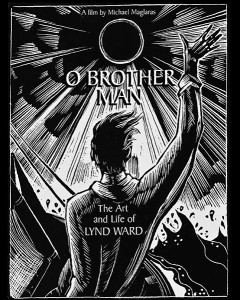O Brother Man
 O Brother Man: The Art and Life of Lynd Ward
O Brother Man: The Art and Life of Lynd Ward
Lynd Ward was an artist known for both his award winning work as an illustrator and his groundbreaking work as the creator of six published novels told entirely through woodcut prints.
Born in Chicago, Illinois at the turn of the 20th century, Ward was the son Harry F. Ward who served two decades as the American Civil Liberties Union’s first chairman. His father’s influence is obvious in the decidedly “left” social themes explored in the artist’s illustrated narratives.
Regarded by many as the father of the American “graphic novel”, Ward’s experimentation with the use of sequential images as the sole means of conveying narrative provided early examples of the importance of considered economy and accessible archetype in illustrated long form storytelling.
Over the course of his life, Ward illustrated many children’s books including the popular “The Little Red Lighthouse and the Great Gray Bridge” by Hildegarde Swift (1942). He also received the Caldecott Medal for writing and illustrating “The Biggest Bear” (1953).
His significance as an artist was recently recognized with the publication of the two volume “Lynd Ward: Six novels in Woodcuts” (2007) and the release of the 2012 film “O Brother Man: The Art and Life of Lynd Ward” by Michael Maglaras. “Six Novels” and “O Brother Man” are both available in the Ladd Library.
“Six Novels” reprints each of Ward’s previously individually published woodcut novels including his first and best known Faustian story “Gods’ Man” (1929). This two volume set is presented with an excellent introduction by award winning writer and illustrator Art Spiegelman. Spiegelman’s highly recommended seminal work “Maus: A Survivor’s Tale” (1991) serves as an example of contemporary adult storytelling through images and words. Two highlights from his collection of covers from “The New Yorker Magazine” are his visual commentary on the tax season (April 17, 1995) and his haunting post-9/11 image depicting the unoccupied negative space of the missing World Trade Center towers (September 24, 2001). “Maus” and archives of “The New Yorker” are both available through Ladd Library.
“O Brother Man” serves as a Ward biography and display of selected works. Much of the “color” in the film is provided by scenes from an extensive interview with the artist’s daughter Robin Ward. Her anecdote about her father making preliminary sketches of the “Little Red Lighthouse” is one great example.
In addition to the film and two volume collection of novels, Ladd Library also holds first editions of Ward’s first two novels: “Gods’ Man” (1929) and the more ambitious (but less successful) “Mad Man’s Drum” (1930). These rare books are available for in-building viewing from the Muskie Archives. This provides a terrific opportunity to see these rare books as they were first issued.